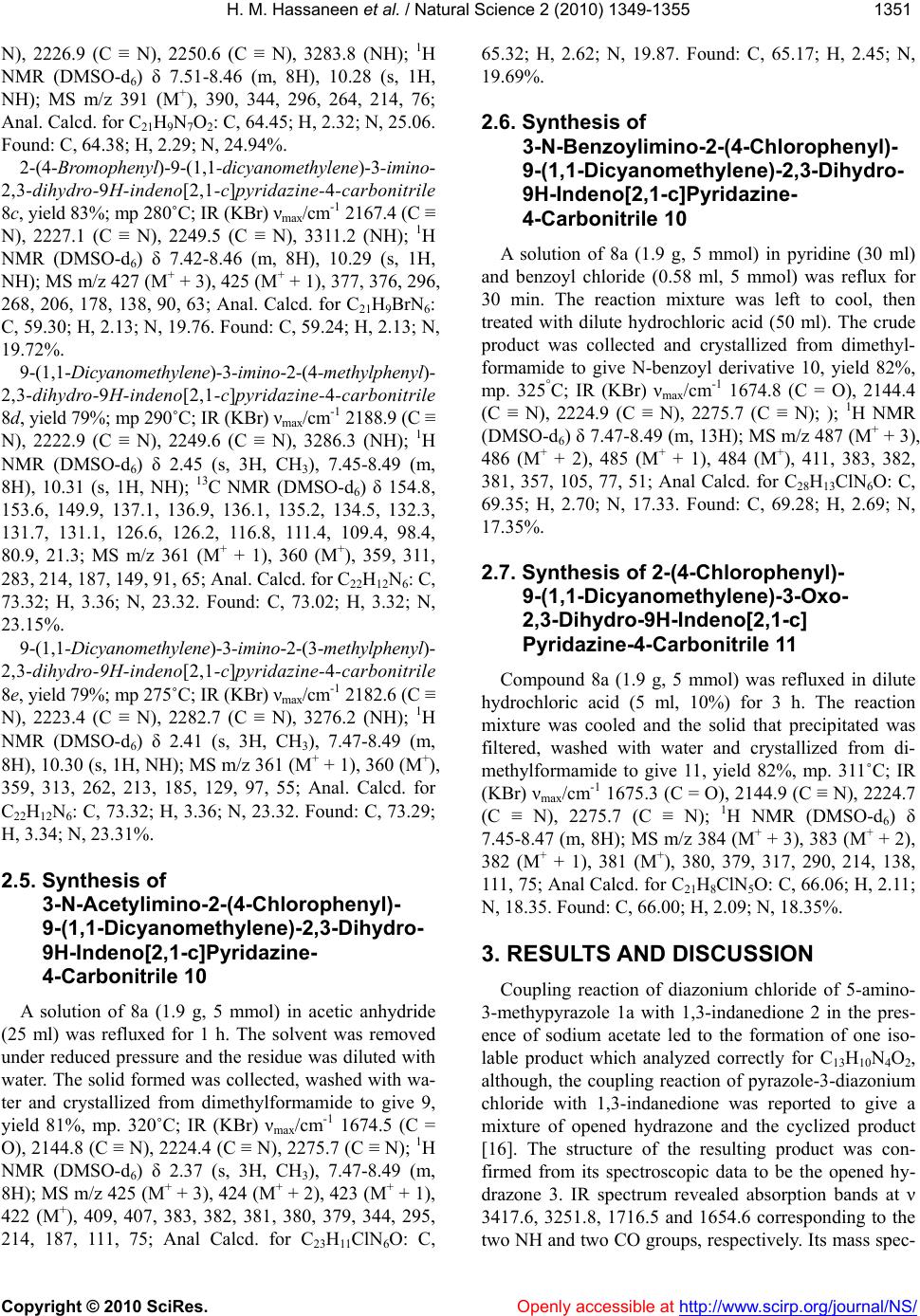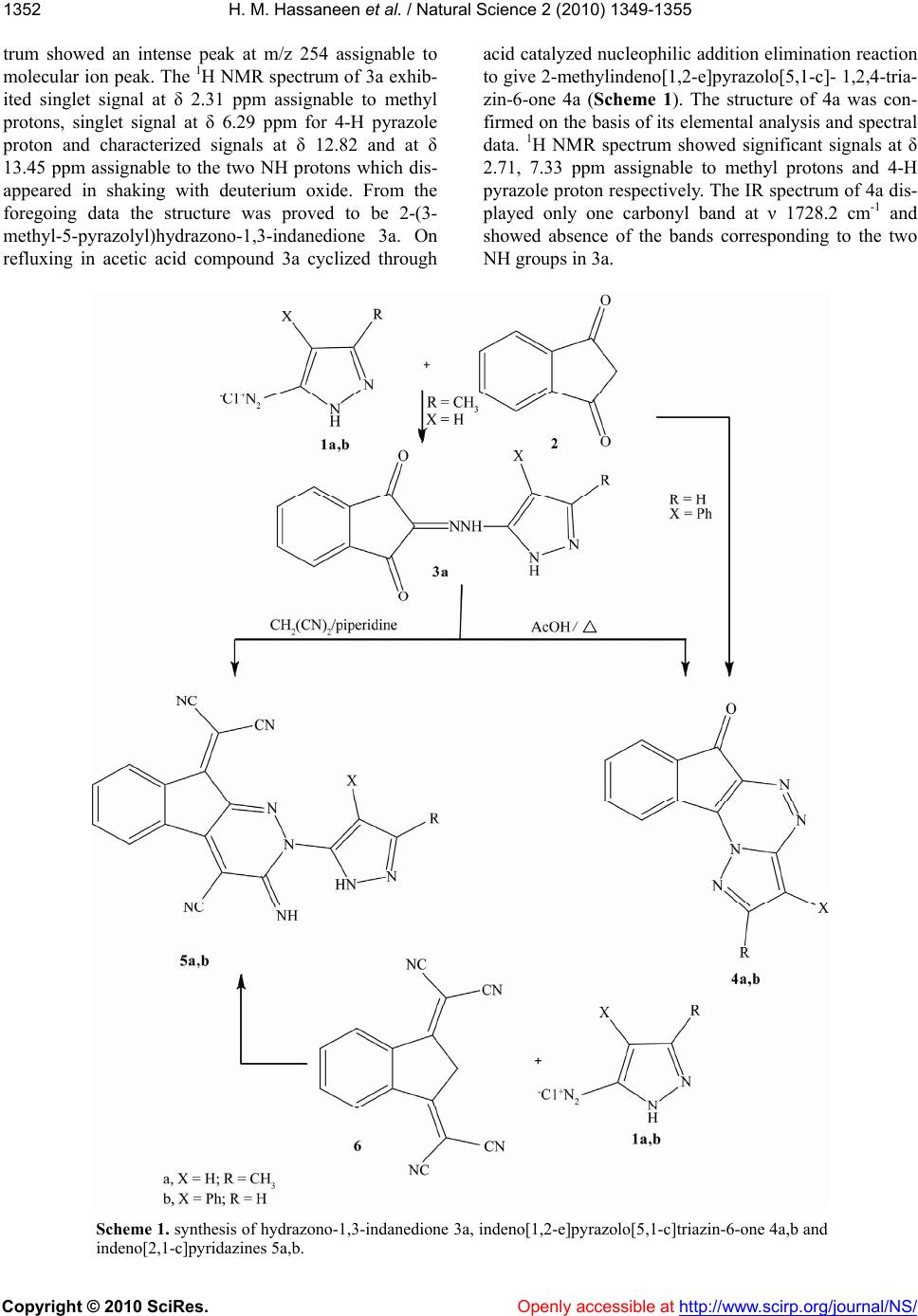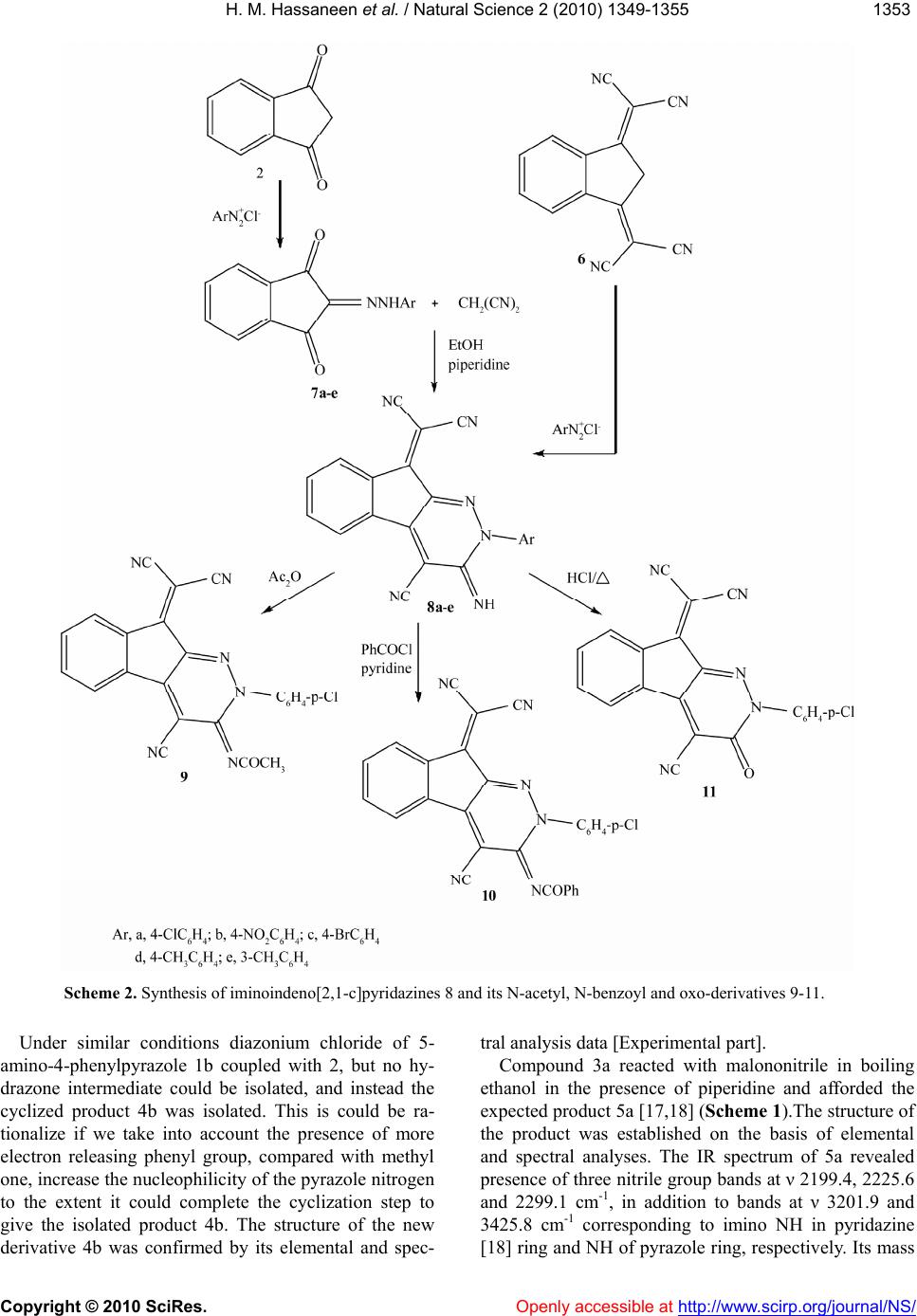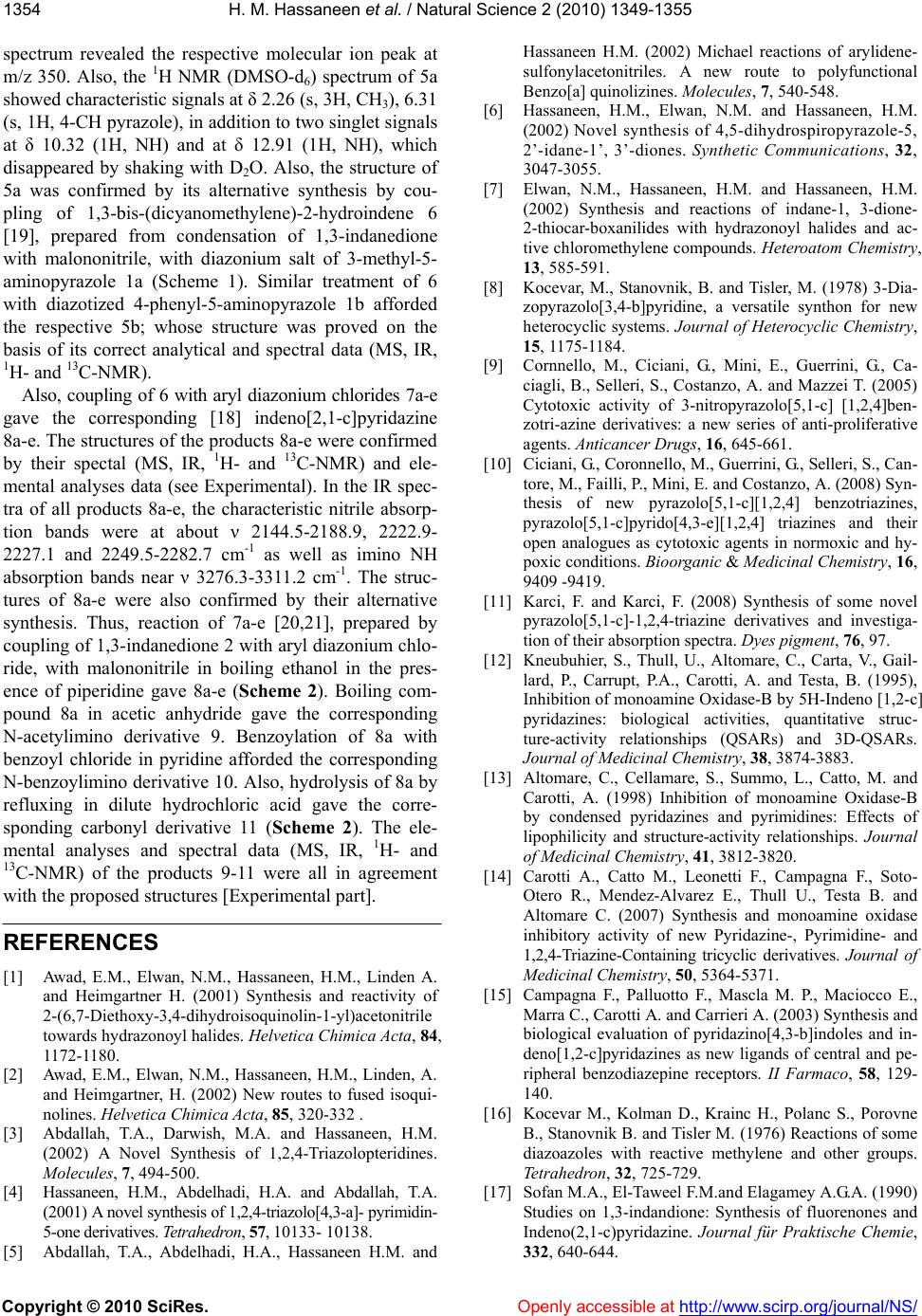 Vol.2, No.12, 1349-135 doi:10.4236/ns.2010.212164 Copyright © 2010 SciRes. Openly accessible at http:// www.scirp.org/journal/NS/ 5 (2010) Natural Science Synthesis of some new indeno[1,2-e]pyrazolo[5,1-c]-1,2,4-triazin-6-one and indeno[2,1-c]pyridazine-4-carbonitrile derivatives Hamdi M. Hassaneen1*, Nada M. Abunada2, Huwaida M. Hassaneen1 1Department of Chemistry, Faculty of Science, Cairo University, Cairo, Egypt; *Corresponding Author: Hamdihass@gmail.com 2Department of Chemistry, Faculty of Applied Sciences, Al-Aqsa University, Gaza, Palestine Received 5 October 2010; 8 November 2010; accepted 12 November 2010. ABSTRACT Diazonium chlorides of 5-amino-3-methypyra- zole 1a and 5-amino-4-phenylpyrazole 1b cou- pled with 1,3-indanedione 2 and led to the for- mation of acyclic hydrazone 3a and a cyclic product indenopyrazolotriazine 4b respectively. Cyclization of the hydrazone 3a by boiling in acetic acid afforded the corresponding 4a. The hydrazone 3a reacted with malononitrile in boiling ethanol in the presence of piperidine and gave indeno[2,1-c]pyridazine-4-carbonitrile de- rivatives 5a,b. Also, coupling of 6 with aryl dia- zonium chlorides gave the corresponding in- denopyridazine derivatives 8a-e. Acetylation, benzoylation and hydrolysis of compound 8a afforded the corresponding substitution prod- ucts 10-12, respectively. The structures of the newly synthesized compounds were estab- lished on the basis of chemical and spectral evidences. Keywords: Diazonium Chlorides; Indenopyrazol otr iaz ine; Indenopyri d azine 1. INTRODUCTION As a part of our program aimed to developing synthe- sis of functionally substituted heteroaromatics from readily starting materials [1-5], we have previously re- ported the synthesis of 4,5-dihydrospiropyrazole-indane-1, 3-diones [6] and thiadiazoline derivatives [7] via reac- tion of hydrazonoyl halides with 2-arylidene indane-1, 3-dione and indane-1,3-dione-2-thiocarboxanilides, re- spectively. In conjunction of this work we intended here to utilize the known coupling reaction [8] of diazotized heterocyclic amines with active methylene compounds, using 1,3-indanedione as an active methylene compound with unreported heterocyclic amines to synthesize some new derivatives of the title compounds with anticipated biological activities. Our interest in synthesis of some novel indeno[1,2-e]pyrazolo[5,1-c]-1, 2,4-triazines, is owing to the fact that pyrazolo[5,1-c]-1, 2,4-triazines were reported to have remarkable cytotoxic activity against colon, breast and lung carcinoma cells [9], some derivatives show to have selective cytotoxicity in hy- poxic and in normoxic conditions [10], hetarylazo de- rivatives were classified as diazo dyes [11]. Moreover, indeno-fused pyridazines have been reported to show in- hibition potency toward monoamine oxidase-B (MAO-B) [12-14] and to display binding affinity for central ben- zodiazepine receptors [15]. 2. EXPERIMENTAL Melting points were measured on a Gallenkamp elec- trothermal melting point apparatus and are uncorrected. The infrared spectra were recorded in potassium bro- mide disks on a Pye Unicam SP 3-300 and Shimadzu FT-IR 8101 PC infrared spectrophotometer. The 1H NMR (200 MHz) and 13C NMR (50 MHz) spectra were re- corded in DMSO-d6 on a Varian Mercury VX 200 NMR using TMS as the internal reference. Mass spectra were measured on a GCMS-QP 1000 EX spectrometer at 70 eV. Elemental analyses were carried out at the Micro- analytical Centre of Cairo University, Giza, Egypt. 2.1. Synthesis of 2-(3-Methylpyrazol-5-yl)Hydrazono-1, 3-Indanedione 3a To a stirred solution of 2 (1.46 g, 10 mmol) in ethanol (100 ml), sodium acetate trihydrate (1.3 g, 10 mmol) was added. After stirring for 15 min, the mixture was cooled to 0˚C and treated with a cold solution of diazonium salt of aminopyrazole 1a [prepared from 3-methyl-5- aminopyrazole (0.97 g, 10 mmol) and appropriate quan- tity of hydrochloric acid and sodium nitrite]. The prod-  H. M. Hassaneen et al. / Natural Science 2 (2010) 1349-1355 Copyright © 2010 SciRes. Openly accessible at http:// www.scirp.org/journal/NS/ 1350 uct separated on standing, was collected and crystallized from dimethylformamide to give 3a in 70% yield; mp 240˚C; IR (KBr) νmax/cm-1 1654.6 (C = O), 1716.5 (C = O), 3251.8 (NH), 3417.6 (NH); 1H NMR (DMSO-d6) δ 2.31 (s, 3H, CH3), 6.29 (s, 1H, pyrazole 4-CH), 7.81- 8.19 (m, 4H, ArH’s), 12.82 (s, 1H, NH), 13.45 (s, 1H, NH) ppm; 13C NMR (DMSO-d6) δ 167.9, 153.7, 145.9, 135.6, 134.8, 130.9, 121.7, 93.8, 15.7; MS m/z 255 (M+ + 1), 254 (M+), 213, 186, 158, 102, 76, 67; Anal. Calcd. for C13H10N4O2: C, 61.41; H, 3.96; N, 22.04. Found: C, 61.22; H, 3.79; N, 21.76%. 2.2. Synthesis of 2-Methyl-6H-Indeno[1,2-e]Pyrazolo [5,1-c]-1,2,4-Triazin-6-One 4a Compound 3a (1.27 g, 5 mmol) was refluxed in boil- ing acetic acid for 2 h, excess solvent was evaporated under reduced pressure, and the residue was treated with methanol (10 ml). The solid that formed was collected and crystallized from dimethylformamide to give 4a in 85% yield; mp 250˚C; IR (KBr) νmax/cm-1 1728.2 (C = O); 1H NMR (DMSO-d6) δ 2.71 (s, 3H, CH3), 7.33 (s, 1H, pyrazole 4-CH), 7.71-8.19 (m, 4H, ArH’s); 13C NMR (DMSO-d6) δ 184.5, 153.6, 151.4, 147.2, 145.8, 139.9, 134.3, 132.6, 128.8, 127.3, 123.6, 96.8, 14.9; MS m/z 237 (M+ + 1), 236 (M+), 195, 168, 143, 139, 114, 88, 53; Anal. Calcd. for C13H8N4O: C, 66.09; H, 3.41; N, 23.72. Found: C, 65.87; H, 3.25; N, 23.54%. 2.3. Synthesis of 3-Phenyl-6H-Indeno[1,2-e]Pyrazolo [5,1-c]-1,2,4-Triazin-6-One 4b The compound was prepared by the same procedure described for the synthesis of compound 3a using 4-phenyl-3-aminopyrazole 1b in place of 1a. The com- pound crystallized from dimethylformamide to give 4b in 70% yield; mp. 290˚C; IR (KBr) νmax/cm-1 1726.6 (C = O); 1H NMR (DMSO-d6) δ 7.32-8.43 (m, 9H, ArH’s), 8.82 (s, 1H, pyrazole 2-CH); 13C NMR (DMSO-d6) δ 184.6, 148.2, 147,3, 139.9, 136.2, 135.7, 132.4, 130.7, 129.7, 129.2, 126.8, 124.7, 123.6, 123.3, 121.6, 97.5; MS m/z 299 (M++1), 298 (M+), 214, 168, 130, 88, 51; Anal. Calcd. for C18H10N4O: C, 72.47; H, 3.38; N, 18.78. Found: C, 72.22; H, 3.25; N, 18.49%. 2.4. Synthesis of 2-(Arylpyrazol-5-yl)- and 2-Aryl-3-Imino-9-(1 ,1-Dicy anomethy lene)- 2-Hydroindeno[2,1-c]Pyridazine-4- carbonitrile 5a,b and 8a-e Method A. To a solution of 3a or 7a-e (5 mmol) and malononitrile (6.6 g, 10 mmol) in absolute ethanol (40 ml) was added 3-4 drops of piperidine at room tempera- ture. The reaction mixture was refluxed for 3h. The sol- vent was evaporated under reduced pressure and the residue was triturated with methanol (10 ml) where it solidified. The crude product was collected and crystal- lized from dimethylformamide to give 5a and 8a-e re- spectively. Method B. To a stirred solution of 6 (2.24 g, 10 mmol) in ethanol (100 ml), sodium acetate trihydrate (1.3 g, 10 mmol) was added. After stirring for 15 min the mixture was cooled to 0˚C and treated with a cold solution of diazonium chloride of aminopyrazoles 1a,b and aromatic amines 9a-e. The product separated on standing was collected by filtration and crystallized from dimethyl- formamide to give compounds 5a,b and 8a-e respec- tively. 9-(1,1-Dicyanomethylene)-3-imino-2-(3-methylpyrazo l-5-yl)-2,3-dihydro-9H-indeno[2,1-c]pyridazine-4-carbo- nitrile 5a, yield 85%; mp 310°C; IR (KBr) νmax/cm-1 2199.4 (C ≡ N), 2225.6 (C ≡ N), 2299.1 (C ≡ N), 3201.9 (NH), 3425.8 (NH); 1H NMR (DMSO-d6) δ 2.2 (s, 3H, CH3), 6.31 (s, 1H, pyrazole 4-CH), 7.91-8.42 (m, 4H), 10.3 (s, 1H, NH), 12.91 (s, 1H, NH); 13C NMR (DMSO-d6) δ 154.9, 153.6, 150.7, 149.7, 136.8, 136.1, 134.9, 132.4, 131.2, 129.5, 126.6, 126.3, 111.4, 110.6, 98.5, 97.8, 80.6, 15.7; MS m/z 350 (M+), 349, 309, 214, 202, 152, 100, 67, 53; Anal. Calcd. for C19H10N8: C, 65.14; H, 2.88; N, 31.99. Found: C, 64.98; H, 2.65; N, 31.85%. 9-(1,1-Dicyanomethylene)-3-imino-2-(4-phenylpyrazo l-5-yl)-2,3-dihydro-9H-indeno[2,1-c]pyridazine-4-carbo- nitrile 5b, yield 85%; mp 322˚C; IR (KBr) νmax/cm-1 2197.2 (C ≡ N), 2223.1 (C ≡ N), 2299.3 (C ≡ N), 3209.1 (NH), 3429.3 (NH); 1H NMR (DMSO-d6) δ 7.73-8.42 (m, 10H, ArH’s), 10.43 (s, 1H, NH), 12.90 (s, 1H, NH); 13C NMR (DMSO-d6) δ 155.1, 153.8, 151.5, 149.6, 136.7, 136.0, 134.5, 132.6, 131.4, 131.1, 129.3, 129.1, 128.4, 126.1, 126.5, 112.4, 111.6, 110.8, 98.8, 97.9, 80.0; MS m/z 413 (M+ + 1), 412 (M+), 387, 348, 329, 214, 202, 152, 103, 64, 50; Anal. Calcd. for C24H12N8: C, 69.89; H, 2.93; N, 27.17. Found: C, 69.87; H, 2.93; N, 27.18%. 2-(4-Chlorophenyl)-9-(1,1-dicyanomethylene)-3-imino- 2,3-dihydro-9H-indeno[2,1-c]pyridazine-4-carbonitrile 8a, yield 80%; mp 310˚C; IR (KBr) νmax/cm-1 2144.5 (C ≡ N), 2225.3 (C ≡ N), 2275.6 (C ≡ N), 3301.3 (NH); 1H NMR (DMSO-d6) δ 7.45-8.46 (m, 8H), 10.29 (s, 1H, NH); MS m/z 383 (M+ + 3), 382 (M++2), 381 (M++1), 380 (M+), 379, 334, 290, 214, 159, 111, 75; Anal. Calcd. for C21H9ClN6: C, 66.24; H, 2.38; N, 22.07. Found: C, 66.98; H, 2.38; N, 22.08%. 9-(1,1-Dicyanomethylene)-3-imino-2-(4-nitrophenyl)- 2,3-dihydro-9H-indeno[2,1-c]pyridazine-4-carbonitrile 8b, yield 77%; mp 315˚C; IR (KBr) νmax/cm-1 2167.5 (C ≡  H. M. Hassaneen et al. / Natural Science 2 (2010) 1349-1355 Copyright © 2010 SciRes. Openly accessible at http://www.scirp.org/journal/NS/ 135 1351 N), 2226.9 (C ≡ N), 2250.6 (C ≡ N), 3283.8 (NH); 1H NMR (DMSO-d6) δ 7.51-8.46 (m, 8H), 10.28 (s, 1H, NH); MS m/z 391 (M+), 390, 344, 296, 264, 214, 76; Anal. Calcd. for C21H9N7O2: C, 64.45; H, 2.32; N, 25.06. Found: C, 64.38; H, 2.29; N, 24.94%. 2-(4-Bromophenyl)-9-(1,1-dicyanomethylene)-3-imino- 2,3-dihydro-9H-indeno[2,1-c]pyridazine-4-carbonitrile 8c, yield 83%; mp 280˚C; IR (KBr) νmax/cm-1 2167.4 (C ≡ N), 2227.1 (C ≡ N), 2249.5 (C ≡ N), 3311.2 (NH); 1H NMR (DMSO-d6) δ 7.42-8.46 (m, 8H), 10.29 (s, 1H, NH); MS m/z 427 (M+ + 3), 425 (M+ + 1), 377, 376, 296, 268, 206, 178, 138, 90, 63; Anal. Calcd. for C21H9BrN6: C, 59.30; H, 2.13; N, 19.76. Found: C, 59.24; H, 2.13; N, 19.72%. 9-(1,1-Dicyanomethylene)-3-imino-2-(4-methylphenyl)- 2,3-dihydro-9H-indeno[2,1-c]pyridazine-4-carbonitrile 8d, yield 79%; mp 290˚C; IR (KBr) νmax/cm-1 2188.9 (C ≡ N), 2222.9 (C ≡ N), 2249.6 (C ≡ N), 3286.3 (NH); 1H NMR (DMSO-d6) δ 2.45 (s, 3H, CH3), 7.45-8.49 (m, 8H), 10.31 (s, 1H, NH); 13C NMR (DMSO-d6) δ 154.8, 153.6, 149.9, 137.1, 136.9, 136.1, 135.2, 134.5, 132.3, 131.7, 131.1, 126.6, 126.2, 116.8, 111.4, 109.4, 98.4, 80.9, 21.3; MS m/z 361 (M+ + 1), 360 (M+), 359, 311, 283, 214, 187, 149, 91, 65; Anal. Calcd. for C22H12N6: C, 73.32; H, 3.36; N, 23.32. Found: C, 73.02; H, 3.32; N, 23.15%. 9-(1,1-Dicyanomethylene)-3-imino-2-(3-methylphenyl)- 2,3-dihydro-9H-indeno[2,1-c]pyridazine-4-carbonitrile 8e, yield 79%; mp 275˚C; IR (KBr) νmax/cm-1 2182.6 (C ≡ N), 2223.4 (C ≡ N), 2282.7 (C ≡ N), 3276.2 (NH); 1H NMR (DMSO-d6) δ 2.41 (s, 3H, CH3), 7.47-8.49 (m, 8H), 10.30 (s, 1H, NH); MS m/z 361 (M+ + 1), 360 (M+), 359, 313, 262, 213, 185, 129, 97, 55; Anal. Calcd. for C22H12N6: C, 73.32; H, 3.36; N, 23.32. Found: C, 73.29; H, 3.34; N, 23.31%. 2.5. Synthesis of 3-N-Acetylimino-2-(4-Chlorophenyl)- 9-(1,1-Dicyanomethylene)-2,3-Dihydro- 9H-Indeno[2,1-c]Pyridazine- 4-Carbonitrile 10 A solution of 8a (1.9 g, 5 mmol) in acetic anhydride (25 ml) was refluxed for 1 h. The solvent was removed under reduced pressure and the residue was diluted with water. The solid formed was collected, washed with wa- ter and crystallized from dimethylformamide to give 9, yield 81%, mp. 320˚C; IR (KBr) νmax/cm-1 1674.5 (C = O), 2144.8 (C ≡ N), 2224.4 (C ≡ N), 2275.7 (C ≡ N); 1H NMR (DMSO-d6) δ 2.37 (s, 3H, CH3), 7.47-8.49 (m, 8H); MS m/z 425 (M+ + 3), 424 (M+ + 2), 423 (M+ + 1), 422 (M+), 409, 407, 383, 382, 381, 380, 379, 344, 295, 214, 187, 111, 75; Anal Calcd. for C23H11ClN6O: C, 65.32; H, 2.62; N, 19.87. Found: C, 65.17; H, 2.45; N, 19.69%. 2.6. Synthesis of 3-N-Benzoylimino-2-(4-Chlorophenyl)- 9-(1,1-Dicyanomethylene)-2,3-Dihydro- 9H-Indeno[2,1-c]Pyridazine- 4-Carbonitrile 10 A solution of 8a (1.9 g, 5 mmol) in pyridine (30 ml) and benzoyl chloride (0.58 ml, 5 mmol) was reflux for 30 min. The reaction mixture was left to cool, then treated with dilute hydrochloric acid (50 ml). The crude product was collected and crystallized from dimethyl- formamide to give N-benzoyl derivative 10, yield 82%, mp. 325°C; IR (KBr) νmax/cm-1 1674.8 (C = O), 2144.4 (C ≡ N), 2224.9 (C ≡ N), 2275.7 (C ≡ N); ); 1H NMR (DMSO-d6) δ 7.47-8.49 (m, 13H); MS m/z 487 (M+ + 3), 486 (M+ + 2), 485 (M+ + 1), 484 (M+), 411, 383, 382, 381, 357, 105, 77, 51; Anal Calcd. for C28H13ClN6O: C, 69.35; H, 2.70; N, 17.33. Found: C, 69.28; H, 2.69; N, 17.35%. 2.7. Synthesis of 2-(4-Chlorophenyl)- 9-(1,1-Dicyanomethylene)-3-Oxo- 2,3-Dihydro-9H-Indeno[2,1-c] Pyridazine-4-Carbonitrile 11 Compound 8a (1.9 g, 5 mmol) was refluxed in dilute hydrochloric acid (5 ml, 10%) for 3 h. The reaction mixture was cooled and the solid that precipitated was filtered, washed with water and crystallized from di- methylformamide to give 11, yield 82%, mp. 311˚C; IR (KBr) νma x /c m-1 1675.3 (C = O), 2144.9 (C ≡ N), 2224.7 (C ≡ N), 2275.7 (C ≡ N); 1H NMR (DMSO-d6) δ 7.45-8.47 (m, 8H); MS m/z 384 (M+ + 3), 383 (M+ + 2), 382 (M+ + 1), 381 (M+), 380, 379, 317, 290, 214, 138, 111, 75; Anal Calcd. for C21H8ClN5O: C, 66.06; H, 2.11; N, 18.35. Found: C, 66.00; H, 2.09; N, 18.35%. 3. RESULTS AND DIS CUSSION Coupling reaction of diazonium chloride of 5-amino- 3-methypyrazole 1a with 1,3-indanedione 2 in the pres- ence of sodium acetate led to the formation of one iso- lable product which analyzed correctly for C13H10N4O2, although, the coupling reaction of pyrazole-3-diazonium chloride with 1,3-indanedione was reported to give a mixture of opened hydrazone and the cyclized product [16]. The structure of the resulting product was con- firmed from its spectroscopic data to be the opened hy- drazone 3. IR spectrum revealed absorption bands at ν 3417.6, 3251.8, 1716.5 and 1654.6 corresponding to the two NH and two CO groups, respectively. Its mass spec-  H. M. Hassaneen et al. / Natural Science 2 (2010) 1349-1355 Copyright © 2010 SciRes. http://www.scirp.org/journal/NS/ 1352 trum showed an intense peak at m/z 254 assignable to molecular ion peak. The 1H NMR spectrum of 3a exhib- ited singlet signal at δ 2.31 ppm assignable to methyl protons, singlet signal at δ 6.29 ppm for 4-H pyrazole proton and characterized signals at δ 12.82 and at δ 13.45 ppm assignable to the two NH protons which dis- appeared in shaking with deuterium oxide. From the foregoing data the structure was proved to be 2-(3- methyl-5-pyrazolyl)hydrazono-1,3-indanedione 3a. On refluxing in acetic acid compound 3a cyclized through acid catalyzed nucleophilic addition elimination reaction to give 2-methylindeno[1,2-e]pyrazolo[5,1-c]- 1,2,4-tria- zin-6-one 4a (Scheme 1). The structure of 4a was con- firmed on the basis of its elemental analysis and spectral data. 1H NMR spectrum showed significant signals at δ 2.71, 7.33 ppm assignable to methyl protons and 4-H pyrazole proton respectively. The IR spectrum of 4a dis- played only one carbonyl band at ν 1728.2 cm-1 and showed absence of the bands corresponding to the two NH groups in 3a. Scheme 1. synthesis of hydrazono-1,3-indanedione 3a, indeno[1,2-e]pyrazolo[5,1-c]triazin-6-one 4a,b and indeno[2,1-c]pyridazines 5a,b. Openly accessible at  H. M. Hassaneen et al. / Natural Science 2 (2010) 1349-1355 Copyright © 2010 SciRes. Openly accessible at http://www.scirp.org/journal/NS/ 135 1353 Scheme 2. Synthesis of iminoindeno[2,1-c]pyridazines 8 and its N-acetyl, N-benzoyl and oxo-derivatives 9-11. Under similar conditions diazonium chloride of 5- amino-4-phenylpyrazole 1b coupled with 2, but no hy- drazone intermediate could be isolated, and instead the cyclized product 4b was isolated. This is could be ra- tionalize if we take into account the presence of more electron releasing phenyl group, compared with methyl one, increase the nucleophilicity of the pyrazole nitrogen to the extent it could complete the cyclization step to give the isolated product 4b. The structure of the new derivative 4b was confirmed by its elemental and spec- tral analysis data [Experimental part]. Compound 3a reacted with malononitrile in boiling ethanol in the presence of piperidine and afforded the expected product 5a [17,18] (Scheme 1).The structure of the product was established on the basis of elemental and spectral analyses. The IR spectrum of 5a revealed presence of three nitrile group bands at ν 2199.4, 2225.6 and 2299.1 cm-1, in addition to bands at ν 3201.9 and 3425.8 cm-1 corresponding to imino NH in pyridazine [18] ring and NH of pyrazole ring, respectively. Its mass  H. M. Hassaneen et al. / Natural Science 2 (2010) 1349-1355 Copyright © 2010 SciRes. Openly accessible at http:// www.scirp.org/journal/NS/ 1354 spectrum revealed the respective molecular ion peak at m/z 350. Also, the 1H NMR (DMSO-d6) spectrum of 5a showed characteristic signals at δ 2.26 (s, 3H, CH3), 6.31 (s, 1H, 4-CH pyrazole), in addition to two singlet signals at δ 10.32 (1H, NH) and at δ 12.91 (1H, NH), which disappeared by shaking with D2O. Also, the structure of 5a was confirmed by its alternative synthesis by cou- pling of 1,3-bis-(dicyanomethylene)-2-hydroindene 6 [19], prepared from condensation of 1,3-indanedione with malononitrile, with diazonium salt of 3-methyl-5- aminopyrazole 1a (Scheme 1). Similar treatment of 6 with diazotized 4-phenyl-5-aminopyrazole 1b afforded the respective 5b; whose structure was proved on the basis of its correct analytical and spectral data (MS, IR, 1H- and 13C-NMR). Also, coupling of 6 with aryl diazonium chlorides 7a-e gave the corresponding [18] indeno[2,1-c]pyridazine 8a-e. The structures of the products 8a-e were confirmed by their spectal (MS, IR, 1H- and 13C-NMR) and ele- mental analyses data (see Experimental). In the IR spec- tra of all products 8a-e, the characteristic nitrile absorp- tion bands were at about ν 2144.5-2188.9, 2222.9- 2227.1 and 2249.5-2282.7 cm-1 as well as imino NH absorption bands near ν 3276.3-3311.2 cm-1. The struc- tures of 8a-e were also confirmed by their alternative synthesis. Thus, reaction of 7a-e [20,21], prepared by coupling of 1,3-indanedione 2 with aryl diazonium chlo- ride, with malononitrile in boiling ethanol in the pres- ence of piperidine gave 8a-e (Scheme 2). Boiling com- pound 8a in acetic anhydride gave the corresponding N-acetylimino derivative 9. Benzoylation of 8a with benzoyl chloride in pyridine afforded the corresponding N-benzoylimino derivative 10. Also, hydrolysis of 8a by refluxing in dilute hydrochloric acid gave the corre- sponding carbonyl derivative 11 (Scheme 2). The ele- mental analyses and spectral data (MS, IR, 1H- and 13C-NMR) of the products 9-11 were all in agreement with the proposed structures [Experimental part]. REFERENCES [1] Awad, E.M., Elwan, N.M., Hassaneen, H.M., Linden A. and Heimgartner H. (2001) Synthesis and reactivity of 2-(6,7-Diethoxy-3,4-dihydroisoquinolin-1-yl)acetonitrile towards hydrazonoyl halides. Helvetica Chimica Acta, 84, 1172-1180. [2] Awad, E.M., Elwan, N.M., Hassaneen, H.M., Linden, A. and Heimgartner, H. (2002) New routes to fused isoqui- nolines. Helvetica Chimica Acta, 85, 320-332 . [3] Abdallah, T.A., Darwish, M.A. and Hassaneen, H.M. (2002) A Novel Synthesis of 1,2,4-Triazolopteridines. Molecules, 7, 494-500. [4] Hassaneen, H.M., Abdelhadi, H.A. and Abdallah, T.A. (2001) A novel synthesis of 1,2,4-triazolo[4,3-a]- pyrimidin- 5-one derivatives. Tetrahedron, 57, 10133- 10138. [5] Abdallah, T.A., Abdelhadi, H.A., Hassaneen H.M. and Hassaneen H.M. (2002) Michael reactions of arylidene- sulfonylacetonitriles. A new route to polyfunctional Benzo[a] quinolizines. Molecules, 7, 540-548. [6] Hassaneen, H.M., Elwan, N.M. and Hassaneen, H.M. (2002) Novel synthesis of 4,5-dihydrospiropyrazole-5, 2’-idane-1’, 3’-diones. Synthetic Communications, 32, 3047-3055. [7] Elwan, N.M., Hassaneen, H.M. and Hassaneen, H.M. (2002) Synthesis and reactions of indane-1, 3-dione- 2-thiocar-boxanilides with hydrazonoyl halides and ac- tive chloromethylene compounds. Heteroatom Chemistry, 13, 585-591. [8] Kocevar, M., Stanovnik, B. and Tisler, M. (1978) 3-Dia- zopyrazolo[3,4-b]pyridine, a versatile synthon for new heterocyclic systems. Journal of Heterocyclic Chemistry, 15, 1175-1184. [9] Cornnello, M., Ciciani, G., Mini, E., Guerrini, G., Ca- ciagli, B., Selleri, S., Costanzo, A. and Mazzei T. (2005) Cytotoxic activity of 3-nitropyrazolo[5,1-c] [1,2,4]ben- zotri-azine derivatives: a new series of anti-proliferative agents. Anticancer Drugs, 16, 645-661. [10] Ciciani, G., Coronnello, M., Guerrini, G., Selleri, S., Can- tore, M., Failli, P., Mini, E. and Costanzo, A. (2008) Syn- thesis of new pyrazolo[5,1-c][1,2,4] benzotriazines, pyrazolo[5,1-c]pyrido[4,3-e][1,2,4] triazines and their open analogues as cytotoxic agents in normoxic and hy- poxic conditions. Bioorganic & Medicinal Chemistry, 16, 9409 -9419. [11] Karci, F. and Karci, F. (2008) Synthesis of some novel pyrazolo[5,1-c]-1,2,4-triazine derivatives and investiga- tion of their absorption spectra. Dyes pigment, 76, 97. [12] Kneubuhier, S., Thull, U., Altomare, C., Carta, V., Gail- lard, P., Carrupt, P.A., Carotti, A. and Testa, B. (1995), Inhibition of monoamine Oxidase-B by 5H-Indeno [1,2-c] pyridazines: biological activities, quantitative struc- ture-activity relationships (QSARs) and 3D-QSARs. Journal of Medicinal Chemistry, 38, 3874-3883. [13] Altomare, C., Cellamare, S., Summo, L., Catto, M. and Carotti, A. (1998) Inhibition of monoamine Oxidase-B by condensed pyridazines and pyrimidines: Effects of lipophilicity and structure-activity relationships. Journal of Medicinal Chemistry, 41, 3812-3820. [14] Carotti A., Catto M., Leonetti F., Campagna F., Soto- Otero R., Mendez-Alvarez E., Thull U., Testa B. and Altomare C. (2007) Synthesis and monoamine oxidase inhibitory activity of new Pyridazine-, Pyrimidine- and 1,2,4-Triazine-Containing tricyclic derivatives. Journal of Medicinal Chemistry, 50, 5364-5371. [15] Campagna F., Palluotto F., Mascla M. P., Maciocco E., Marra C., Carotti A. and Carrieri A. (2003) Synthesis and biological evaluation of pyridazino[4,3-b]indoles and in- deno[1,2-c]pyridazines as new ligands of central and pe- ripheral benzodiazepine receptors. II Farmaco, 58, 129- 140. [16] Kocevar M., Kolman D., Krainc H., Polanc S., Porovne B., Stanovnik B. and Tisler M. (1976) Reactions of some diazoazoles with reactive methylene and other groups. Tetrahedron, 32, 725-729. [17] Sofan M.A., El-Taweel F.M.and Elagamey A.G.A. (1990) Studies on 1,3-indandione: Synthesis of fluorenones and Indeno(2,1-c)pyridazine. Journal für Praktische Chemie, 332, 640-644.  H. M. Hassaneen et al. / Natural Science 2 (2010) 1349-1355 Copyright © 2010 SciRes. http:// www.scirp.org/journal/NS/ Openly accessible at 135 1355 [18] Junek H., Klade M. and Sterk H. (1989) Über Dicyan- methylen-aminoindene, Indano-pyridazine und Indano- pyridine. Synthesen mit Nitrilen, 83. Mitt. Monatshefte für Chemie, 120, 781-788. [19] Gudriniece, E., Pastors, P. and Ievins, A. (1972) Con- densaton of 1,3-indanedione with malononilrile. Doklady Akademii Nauk SSSR, 204, 874-875. [20] Hocaoglu, N. and Uyar, T. (1987) Substituent and solvent effect on visible absorption spectra of 2-Substituted Phenylazo-1,3-indandiones. Journal of Spectroscopy, 8, 23-34. [21] Hocaoglu, N., Uyar, T. and Turker, L. (1990) “The Syn- thesis of Some Novel 2-Substituted Phenylazo- 1,3- in- dandiones,” Dyes Pigments, 12, 187-195.
|